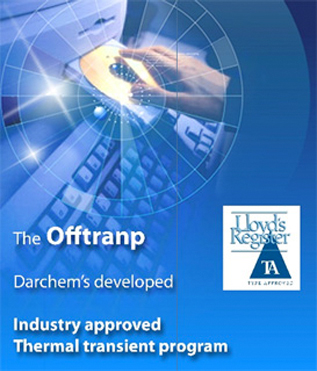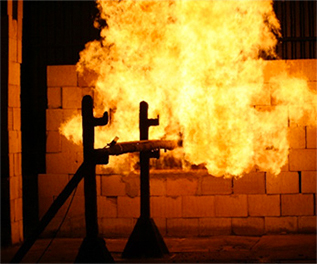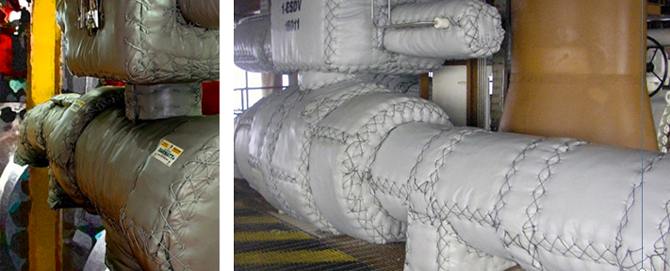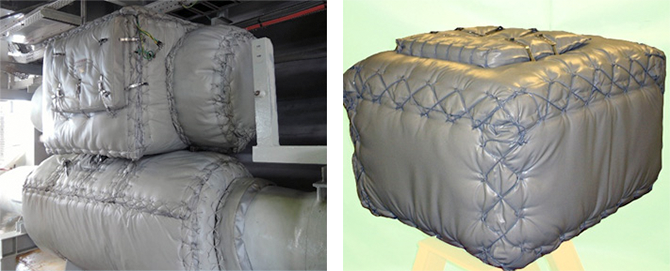OPTIMISATION OF INSULATION THICKNESS

We use Lloyds approved software called “Offtranp” to determine the optimal insulation thickness for each PFP application. This ensures that adequate insulation is provided to protect the equipment in the fire condition and that the thickness of the insulation is kept to the absolute minimum.
The factors below are input into the “Offtranp” software, which calculates and displays the temperature drop across the insulation after a set period of time during the fire.
- · Type of Fire
- · Duration of Fire
- · Limiting Temperature Rise
- · Relevant ambient and operating temperatures
- · Mass and volume of Equipment
- · Exposed Surface Area
TESTING & CERTIFICATION

Since its introduction the Darmatt PFP System has been tested continuously to prove its capability as a passive fire protection system.
The Darmatt PFP system is ideally suited to protect ESD valves and process equipment against hydrocarbon engulfment and Jet Fire.
The Darmatt™ PFP System is Lloyds Type Approved and also holds accreditation from DNV and ABS.
-
DARMATT™ PFP SYSTEM

Darmatt™ PFP system is specifically engineered to fit closely around the protected equipment providing a removable, compact and user friendly enclosure. The Darmatt™ PFP system is constructed from pre-shaped panels designed to fit together around the equipment to be protected.
-
INSPECTION HATCHES AND PENETRATION

Inspection hatches can be provided for each Darmatt™ installation to provide quick access to areas of the protected equipment that requires regular inspection or maintenance.
Lloyds have approved these hatches for use along with the Darmatt™ PFP system. -
DESIGN SPECIFICATION

- · Fire Condition - Hydrocarbon Engulfment / Jet Fires up to 180 mins
- · Blast Protection - Up to 1.62 bar
- · Limiting Temperatures – as per project requirements, with Lloyds approved Offtranp software calculations to be issued to clients for each item of equipment protected.
- · Submission of prepayment design evaluation materials tailored to the specifications of each project as needed.
-
DARMATT FLEXIBLE PFP SYSTEM
Darmatt™ flexible jacket Passive Fire Protection system is a high performance solution designed to meet the most demanding requirements for protection of critical flow and process equipment from Hydrocarbon Pool Fire conditions. Offering up to an unprecedented 180 minutes protection, Darmatt™ can be fitted to valves, actuators, instrument panels, process vessels, cable trays, tube & pipework and has been supplied extensively worldwide for both Onshore and Offshore Oil & Gas and Petrochemical installations.
-
PENETRATION
Penetrations for operating mechanisms, hydraulic tubing and position indicators etc.
can be provided to facilitate problem-free operation and maintenance of equipment without the need to remove the jackets. -
DARMATT™ PFP LACING METHOD
The Darmatt PFP system is fastened together using high quality PVC coated stainless steel wire lacing. This lacing method is simple to apply and provides an extremely durable fastening, ensuring that the panels are secured permanently.
By using this lacing method, the panels can be pulled tight around the equipment in such a way that they take shape around the valve/actuator.
Once installed each panel will retain its moulded shape making future removal/installation quicker and easier. -
Project Execution Process (PFP Design and Production Delivery)
- · Review optimal installation approach through analysis of Hardware Drawings for each target item (Vendor G.A. Drawings)
-
·
Verify interference factors around target items – Conduct on-site visits as necessary for investigation and measurements
(Confirming access door, penetration requirements, orientation, etc.) - · Calculate thermal conductivity for each target item to apply optimal design (Calculation data will be submitted to the End User)
- · Prepare individual drawings including project requirement specifications and design application data, and submit to the client (Request for approval)
- · Upon client approval, submit design drawings and thermal conductivity calculations to Lloyd Fire Safety for design validation review
- · Develop and submit installation procedure manual for each target item type upon delivery
- · Submit documentation related to quality assurance

